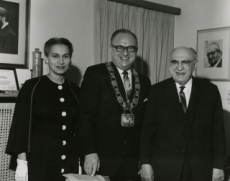The OJA has recently processed the records of former Toronto mayor, Phil Givens. The fonds consists of several boxes of textual records, artifacts, political cartoons, and scrapbooks as well as over 900 remarkable photographs documenting Givens' political, communal and personal life.
Philip Gerard Givens (1922-1995) was a municipal, provincial and federal politician, a judge, a police commissioner and an active Jewish communal leader. He is largely remembered as the 54th Mayor of Toronto. Although he graduated as a lawyer from Osgoode Hall Law School in 1949, shortly thereafter Givens decided to enter politics, running as a municipal school board trustee in 1950. He then went on to serve as alderman and city controller until 1963. Givens was appointed Queen’s Counsel in 1962.
Following the sudden death of Mayor David Summerville in 1963, Givens was appointed by City Council as the Mayor of Toronto and was officially elected to the position in 1964, winning a close race against the former mayor, Allan Lamport. Givens was publicly seen as an affable and populist mayor but his tenure was not without controversy. His support for the construction of the St. Lawrence Centre for the Arts and his decision to acquire Henry Moore’s bronze sculpture "the Archer" for the new Nathan Phillips Square were both highly controversial during his term in office. In particular, the Moore sculpture sparked intense controversy and public debate amongst council members and citizens alike. Although ultimately purchased with private solicited donations, the controversy surrounding the statue’s purchase was still partly to blame for Givens’ 1966 election defeat to William Dennison.
In 1968, Givens entered national politics for the second time, (the first being a failed 1957 bid in Toronto’s Spadina riding), winning a seat as a Liberal in Toronto’s York West riding. In 1971, he stepped down before the end of his term to campaign for a seat in the Provincial Legislature. Again running under the Liberal banner, Givens won his seat and represented the ridings of York-Forest Hill and Armourdale until 1977, when he officially retired from politics. That same year he was appointed as a provincial court judge and chairman of the Metropolitan Toronto Police Commission, serving in both capacities until 1985, when he left the Commission but continued in the judiciary as a civil trial judge until officially retiring from public life in 1988.
An ardent Zionist, Givens was also a prominent leader of several Jewish communal organizations. He was founder and first president of the Upper Canada Lodge of B’nai Brith and sat on the executives of several Jewish organizations. He was chairman of the United Israel Appeal-Israel Emergency Fund in 1967 and the United Jewish Appeal-Israel Special Fund in 1968. From 1973 to 1985 he was the national president of the Canadian Zionist Federation and in the 1990s was the national chairman of the Canadian Jewish Congress’ Committee for Yiddish. Givens was honoured by many Jewish community organizations and received several awards over his lifetime. Givens was also known to be a passionate sailor and was a member of both the Royal Canadian and the Island Yacht Clubs in Toronto.
The records of former mayor Phil Givens will complement those currently housed at the City of Toronto Archives and will be invaluable to researchers studying municipal, provincial and national politics as well as the history of Jewish communal life in Toronto. The OJA would like to thank Mrs. Min Givens for assisting with the identification of many of the events and individuals depicted in the photographs.
